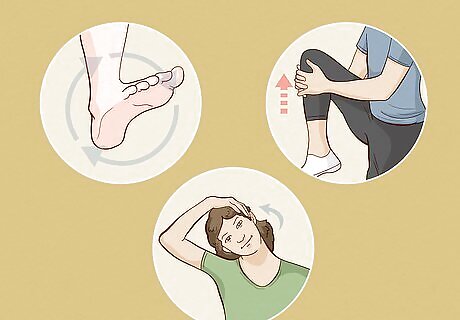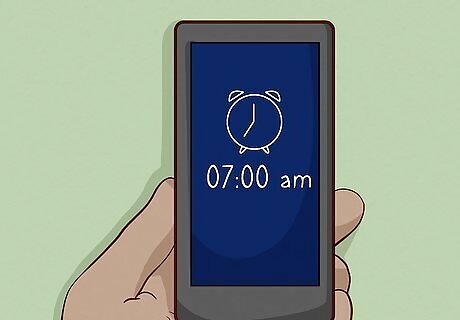
views
X
Research source
Traveling from west to east can also make your jet lag a little more challenging, since your body’s internal clock is losing hours instead of gaining them.[2]
X
Research source
There’s no need to worry, though! We’ve put together plenty of tips, tricks, and precautions to help you cope with jet lag after you land, throughout your flight, and even before you take off.This article is based on an interview with our travel specialist, Greg Guiteras, CEO of Lorraine Travel, LLC. Check out the full interview here.
Adjust your schedule to your new time zone.

Eat and sleep at the right times for your current location. It can be really tempting to take a snooze as soon as you start to feel drowsy—but catching zzzs in the morning, afternoon, or early evening won’t help your jet lag in the long run. Instead, do your best to eat and sleep at the same time as the locals.
Nap for 30 minutes or less.

Long flights can be brutal, especially if you land bright and early in the morning. It can be tempting to hit the hay as soon as you step off the plane, but try to hold off if you can. A short, 30-minute nap is fine if you just need to recharge your batteries, but anything longer than that may make it harder for you to fall asleep later on. Ideally, save your naps for late morning, early afternoon, or anytime that’s at least 8 hours ahead of your usual bedtime.
Get plenty of afternoon sunlight if you traveled east.

Being outdoors in the afternoon will help reset your circadian rhythm. Flying more than 8 time zones at a time can get a little tricky, since it’s easy for your body to confuse early evening light with early morning light. To be safe, stay inside during the morning in the first couple of days after your flight. Once the afternoon rolls around, feel free to head outside and soak in plenty of rays. Slip on a pair of shades if you have to head outside in the morning. This way, your body won’t take in quite as much sunlight. Your circadian rhythm is your body’s internal clock—it lets you know when to fall asleep and when to wake up.
Stay inside during the late afternoon if you headed west.

Head out during the earlier hours to help your body recognize your current time zone. Flying west definitely isn’t as difficult as flying east, but gaining 12 hours of time is still a big adjustment! Reset your internal clock during the first few days by heading inside a couple of hours before the sun sets. The exact times sunrise and sunset will ultimately depend on where you are and what season it is.
Take melatonin to help realign your sleep schedule.

Melatonin helps tell your body when to sleep and when to wake up. While your body produces melatonin on its own, taking melatonin supplements may help your body’s internal clock get back on track after a long trip. Take melatonin at night during the first couple of days in your new time zone. Experts suggest taking anywhere between 0.5 and 5 mg around an hour before your usual bedtime. Feel free to take melatonin the day before you travel, too. Keep in mind that the medical community is pretty divided when it comes to melatonin supplements. To be safe, chat with your doctor to see if melatonin is a good option for you when you travel.
Drink caffeine in the morning if you’re feeling sluggish.

Caffeine can give you a much-needed boost against daytime drowsiness. Sip on a caffeinated drink in the morning, like a cup of cold brew or a glass of your favorite soda. Just be sure to cut yourself off at least 6 hours before you plan on heading to bed. Try not to drink caffeine on the flight, since it can make your dehydration worse.
Stick with foods that you know.

An upset stomach is a common symptom of jet lag. Even if you’re feeling fine, it’s best not to take any chances during the first couple of days after you land. Instead, chow down on snacks and meals that you know and love rather than trying out the local specialties. Once your jet lag goes away, feel free to try as many new foods as you’d like!
Sip plenty of water during the trip.

Dehydration makes you feel even more out of sorts. Jet lag comes with all sorts of annoying side effects, like sleeping problems, fatigue, difficulty focusing, headaches, and more. Unfortunately, dehydration tends to crank up these symptoms, making you feel worse overall. Save yourself the trouble by picking up a water bottle or 2 at the airport, or asking a flight attendant for some water while you’re up in the air.
Steer clear of alcohol throughout your journey.

Alcohol may make you tired, but it won’t help you get a good night’s sleep. A solid, healthy night of rest requires your body to cycle through multiple stages of sleep. Alcohol interferes with these stages, which leads to a bad night of sleep. Stick with water instead—your body will thank you!
Move around during your flight.

A little bit of movement might make your jet lag symptoms less severe. Don’t worry—you don’t have to do any push-ups or jog up and down the aisle! Instead, focus on small exercises, like: Rotating your ankles in circles Lifting your knees up Moving your head back and forth Tightening and relaxing your legs
Get some rest on the flight if it’s nighttime in your destination.

Sleeping on the plane can help you adjust to a new time zone. Think about it this way: if it’s nighttime at your destination while you’re up in the air, use your flight as an opportunity to catch some zzzs. That way, you’ll be “waking up” with the locals by the time you land. Ask your doctor if there are any sleep medications that you can take while on the plane. Some people have had success using medicine to sleep through a long flight. If you’ll be landing at night at your destination, make an effort to stay up during your flight. That way, you can head to bed once you’re on the ground.
Shift your bedtime a few days before the flight to match up with your destination.

Adjust your bedtime in 1-hour increments each night. If you’re taking a trip east, hop into bed an hour before you usually would. If you’re jet-setting west, push your bedtime back by an hour instead. These small changes can make a big difference as you adjust to a 12-hour time zone difference!




















Comments
0 comment